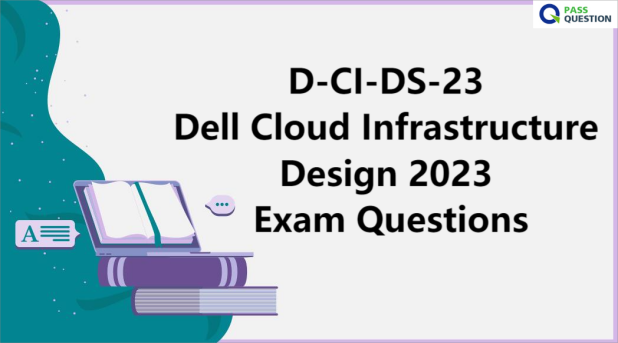
D-CI-DS-23 Dell Cloud Infrastructure Design 2023 Exam Questions
The D-CI-DS-23 Dell Cloud Infrastructure Design 2023 Exam is the updated version of the previously retired DES-2T13 exam. For those preparing to take the test, PassQuestion offers the latest D-CI-DS-23 Dell Cloud Infrastructure Design 2023 Exam Questions which cover a broad spectrum of relevant topics, assisting you in identifying and understanding the areas you need to focus on for improvement. Not only do these questions serve as a comprehensive study guide, but they also provide an efficient way to gauge your current knowledge and skills. The D-CI-DS-23 Dell Cloud Infrastructure Design 2023 Exam Questions have been meticulously crafted to augment your learning experience and instill the confidence needed to excel in the exam.

Dell Cloud Infrastructure Design 2023
This exam focuses on knowledge and skills to successfully design a cloud infrastructure that supports multiple types of services. It tests the ability of data center technology professionals to design robust cloud-based infrastructure incorporating components such as cloud management, consumer resources, elasticity, metering, hybrid capabilities, and disaster recovery. Successfully obtaining this certification enables and validates the candidate's ability to effectively design a cloud infrastructure that supports multiple types of services. The certification supports the skills needed to successfully work within organizations undergoing digital and IT Transformations.
Exam Topics
Topics likely to be covered on this exam include:
Introduction to Cloud Design and Design Parameters (10%)
• Describe digital business imperatives, cloud concepts, cloud infrastructure design approaches and goals
• Describe cloud solutions design project lifecycle phases
• Describe cloud reference architecture and various cloud design considerations for compute, storage, network, CMP, hybrid and multicloud, and application platform and PaaS solution
Data Collection and Analysis (12%)
• Describe data collection process, metrics, and tools
• Describe analysis process, business value analysis, and design best practices
Architecting a Do-It-Yourself Solution (25%)
• Explain the benefits, challenges, and considerations for designing various compute technologies in a cloud infrastructure
• Explain the benefits, challenges, and considerations for designing various network technologies in a cloud infrastructure
• Explain the benefits, challenges, and considerations for designing various storage technologies in a cloud infrastructure
Architecting a CI / HCI Solution (18%)
• Explain design decisions and considerations for converged infrastructure
• Explain design decisions and considerations for hyper-converged and cloud in a box infrastructure
Cloud Management Platform (10%)
• Describe the key functions of a CMP, CMP reference architecture, and CMP infrastructure
• Describe the key requirements and considerations for designing CMP solutions
Hybrid Cloud and Multi Cloud (15%)
• Describe the design considerations for hybrid cloud and multicloud
• Explain disaster recovery considerations
Application Development and Deployment Platform (10%)
• Describe the application development and deployment environment and its requirements
• Explain the design considerations of Do-It-Yourself and Packaged PaaS solutions
View Online Dell Cloud Infrastructure Design 2023 D-CI-DS-23 Free Questions
1. When designing a CI solution, what switch configuration provides greater network capacity but is complex to manage?
A. Unified
B. SAN only
C. LAN and SAN
D. SAN and WAN
Answer: C
2. An organization is planning to deploy CMP components for their private cloud environment. As a cloud architect, why would you recommend a SaaS-based CMP solution?
A. Speeds up the initial deployment and reduces the complexity in managing the CMP solution
B. Allows the organization to use low cost IT resources in order to run the CMP application
C. Allows management of both private and public cloud resources using a legacy unified management tool
D. Requires only a one-time investment and the organization has full control over the CMP solution
Answer: A
3. For what utilization limit should the processing capability of blade and rack servers in a CI solution be sized?
A. 50%
B. 60%
C. 70%
D. 80%
Answer: C
4. During an assessment, you determine that an organization wants to view available services, billing information, performance information, and usage information all from one portal.
Which component may be required in the cloud management platform to enable this capability and have minimal impact on the user experience?
A. LDAP
B. SSL
C. AD
D. SSO
Answer: D
5. As a cloud architect designing a DIY PaaS solution, you have concluded that using VMs to support the target applications is the best choice. What consideration supports that decision?
A. A single operating system reduces management overhead.
B. The abstraction of the physical hardware limits vulnerability.
C. Orchestration supports automated scaling of applications.
D. The software stack is compatible with the run-time environment.
Answer: B
6. Why is it important for a cloud architect to use minimal up-front sizing when planning capacity for nodes in a HCI deployment?
A. Accommodate the workload of a node that has failed or is under maintenance
B. Minimal up-front sizing is correlated to lower licensing costs of the HCI deployment
C. Reduce CAPEX costs of the HCI deployment by sizing for only the capacity required
D. Optimize storage resources by designing only for what is required to run mission critical workloads
Answer: A
7. You plan to gather application performance data from an existing UNIX environment. What should you use?
A. perfmon
B. NaviAnalyzer
C. esxtop
D. SAR
Answer: D
8. A company has the following requirements:
- Distributed application infrastructure
- ERP and CRM systems running on resilient hardware
Which solution is intended to satisfy these requirements?
A. Traditional
B. Converged
C. Hyper-Converged
D. Cloud in a Box
Answer: B
9. How does cloud help accelerate an organization's path toward IT Transformation?
A. Ensures higher quality code
B. Allows IT to operate as usual
C. Ensures quick time-to-market
D. Provides technical capability for IoT
Answer: C
10. What categories of cost are included in CAPEX?
A. Hardware, software, installation, and decommissioning
B. Hardware, software, annual license fees, and maintenance
C. Hardware, software, maintenance, and upgrades
D. Annual license fees, software, maintenance, and upgrades
Answer: A
SIIT Courses and Certification
Also Online IT Certification Courses & Online Technical Certificate Programs

